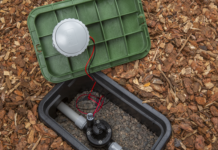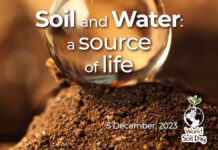Soil quality has a large impact on the intensity of management practices and on the ability of a soil to sustain quality turfgrass. It sounds basic enough, but what exactly is soil? And how do you maximize it?
The major components of soil consist of minerals, water, air, and organic matter. Minerals can be further broken down by size into smaller fractions, which provides soil texture. The main fractions from largest particle size to smallest are sand (2 – 0.05 mm), silt (0.05 – 0.002 mm), and clay (less than 0.002 mm). Soil texture is the mixture of different ratios of sand, silt, and/or clay.

The soil texture and its arrangement—along with the organic matter—determine the main soil properties and its ability to support turfgrass growth. Coarse textured soils (like sandy soils) generally have good drainage and aeration, however, they lack the ability to hold water and nutrients. Conversely, finely textured soils (like clay) normally have improved water and nutrient holding capacities, but have poor drainage and aeration. While soil texture varies from location to location, many turfgrass sites can be generalized.
Disturbed Soil
Typically turfgrass is established and grown on disturbed soils. This is especially true in urban areas, where development removes vegetation, strips the topsoil, and compacts the leftover subsoil. This leads to urban soils generally losing organic matter and soil structure as well as having increased bulk density and reduced permeability. With turfgrass rooting restricted by compaction and other issues, this type of soil can be difficult to manage.
Management in these areas often includes increased fertilizer and irrigation inputs to combat the challenges of the soil compared to less disturbed soils. However, these additional inputs also increase the likelihood of nutrients being lost to the environment. This dynamic puts many turfgrass managers in a difficult balancing act between providing clients with good turfgrass quality, while still trying to be environmentally sensitive.
Soil Properties
As a result, soil health—and its creation—have garnered interest with turfgrass managers focusing more on sustainable management practices. Soil health, or quality, refers to the ability of soil to support plant health, enhance/maintain water quality, and to function and sustain productivity.
Soil health involves all three aspects of soil: physical, chemical, and biological properties. Common examples of physical soil health properties are soil texture, moisture, porosity, and compaction (bulk density). Chemical soil health properties include organic matter, pH, cation exchange capacity, and soil nutrient analysis. Lastly, common biological soil health properties consist of soil microbial biomass and activity, enzymes, and mineralization rates. Improving soil health can increase nutrient cycling and availability, enhance water holding capacity and infiltration, and improve soil structure. There are different management strategies that can improve soil health depending on the timing of application.
Amendments
If possible, amendments should be added to a disturbed soil before turfgrass establishment to improve soil quality. Typically, soil amendments will improve compaction resistance and soil structure, increase water and nutrient holding capacity, and enhance the environment for root growth. There are many different soil amendments that have had positive results when incorporating them into the turfgrass root zone. These are generally organic amendments and include peat-based materials, compost, and humic substances.
Peat. Peat-based materials can improve soil health when incorporated into the root zone. The main reason peat-based materials are added to the soil is to increase water holding capacity. Other benefits of include greater root penetration, improved soil aeration, and decreased bulk density.
Compost. Incorporating compost can improve soil health by influencing all three types of soil properties mentioned previously. Compost can improve physical soil properties by increasing soil aggregation, improving porosity, and enhancing water holding capacity, which can lower irrigation rates and frequency. Compost can also affect chemical soil properties such as increasing organic matter and soil nutrients—and can provide long lasting benefits that maintain plant nutrients in the soil. Additionally, compost provides carbon and nutrients to the soil that can be consumed by microbes, which increases microbial populations and activity. This increase in microbial activity can increase the plant nutrient availability from the residual nutrients in the soil. Overall, incorporating compost in soil prior to turfgrass establishment has many benefits, but it is important to utilize good quality compost which can be variable depending on source and preparation methods to minimize the addition of salts and metals.
Humic substances. Humic substances also have the potential to increase soil health when incorporated into the soil. Humic substances are complex, carbon-rich materials that are formed by reactions during the decay of plants and microbes. Humic substances can increase the availability of micronutrients and phosphorus in the soil. Increasing phosphorus availability is important especially at time of establishment. Humic substances can also increase microbial populations and activity, and enhance nitrogen mineralization, which can result in more nitrogen being available to the turfgrass. Beyond improving soil health, humic substances can improve turfgrass rooting during establishment. Although there are potential benefits to incorporating humic substances to the soil, the benefits can vary depending on the rate of application, soil type, and location.
Established Grass
The addition of soil amendments prior to turfgrass establishment can greatly improve soil health and quality. However, in many instances this is not possible and turfgrass managers have to deal with the soil conditions under established turfgrass. This is typically a more difficult and a longer process compared to adding soil amendments, but it can be done utilizing different fertilizers/amendments and cultural practices.
Applications of natural, organic, or bio-fertilizers and/or compost to existing turfgrass can improve soil quality. These types of fertilizers generally are slow-release products, which reduces the risk of environmental losses of nutrients. Furthermore, long-term applications of these products can increase soil carbon and nutrient levels and reduce bulk density, along with potentially improving water holding capacity. Additionally, these products can increase microbial populations and activity, and improve nitrogen mineralization.
Similar to incorporating humic products in the soil, applying humic products to an established turfgrass stand will also provide benefits including increased turfgrass rooting and improved microbial populations and activity. It may also improve nutrient availability, but more research is needed to verify this. Once again, results of humic substances can be variable, but beneficial in certain circumstances.
Beyond applications of certain fertilizers/compost and amendments, cultural practices should also be used to boost soil quality. The main practices that improve soil quality are aeration and returning clippings. Aeration improves water and nutrient movement, increases air exchange, and reduces soil compaction. Utilizing natural, organic, or bio-fertilizer and/or compost in combination with aeration can further increase soil health. Aerification also improves microbial activity by managing air exchange and water movement. Returning grass clippings improves soil health by increasing microbial activity. This is likely due to the return of nutrients to the soil, which can be utilized by the turfgrass.
The importance of soil in turfgrass management is still being researched and understood, and improving soil health in disturbed soils will continue to be a great challenge. However, there are techniques before and after turfgrass establishment that can enhance soil and lead to better results.
Lindsey is a postdoc research associate in Turfgrass Management in the Department of Horticulture at Iowa State University; and Thoms is an assistant professor in the Department of Horticulture at Iowa State University. This article was arranged with the help of the Soil Science Society of America.











![[VIDEO] Dickies®: Discover Workwear That’s Anything But Uniform](https://turfmagazine.com/wp-content/uploads/2023/06/1647663814-4b1a2a7742790a9b1e97a3b963477850192e1d6a9dfba9b07214a77bae25d6e3-d-218x150.jpg)




























![[VIDEO] Dickies®: Discover Workwear That’s Anything But Uniform](https://turfmagazine.com/wp-content/uploads/2023/06/1647663814-4b1a2a7742790a9b1e97a3b963477850192e1d6a9dfba9b07214a77bae25d6e3-d-324x160.jpg)